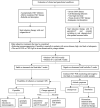A quick algorithmic review on management of viral infectious diseases in pediatric solid organ transplant recipients
- PMID: 37732007
- PMCID: PMC10507262
- DOI: 10.3389/fped.2023.1252495
A quick algorithmic review on management of viral infectious diseases in pediatric solid organ transplant recipients
Abstract
Pediatric solid organ transplant is a life-saving procedure for children with end-stage organ failure. Viral infections are a common complication following pediatric solid organ transplantation (SOT), which can lead to increased morbidity and mortality. Pediatric solid organ transplant recipients are at an increased risk of viral infections due to their immunosuppressed state. The most commonly encountered viruses include cytomegalovirus (CMV), Epstein-Barr virus (EBV), herpes simplex virus (HSV), varicella-zoster virus (VZV), adenoviruses, and BK polyomavirus. Prevention strategies include vaccination prior to transplantation, post-transplant prophylaxis with antiviral agents, and preemptive therapy. Treatment options vary depending on the virus and may include antiviral therapy and sometimes immunosuppression modification. This review provides a Quick Algorithmic overview of prevention and treatment strategies for viral infectious diseases in pediatric solid organ transplant recipient.
Keywords: antiviral; pediatrics; solid organ; transplantation; viral infections.
© 2023 Moghadamnia, Eshaghi, Alimadadi and Dashti-Khavidaki.
Conflict of interest statement
The authors declare that the research was conducted in the absence of any commercial or financial relationships that could be construed as a potential conflict of interest.
Figures











Similar articles
-
Viral prophylaxis in organ transplant patients.Drugs. 2004;64(24):2763-92. doi: 10.2165/00003495-200464240-00004. Drugs. 2004. PMID: 15563248 Review.
-
Infections caused by herpes viruses other than cytomegalovirus in solid organ transplant recipients.Enferm Infecc Microbiol Clin. 2012 Mar;30 Suppl 2:63-9. doi: 10.1016/S0213-005X(12)70084-8. Enferm Infecc Microbiol Clin. 2012. PMID: 22542037 Review.
-
Viral infections affecting the skin in organ transplant recipients: epidemiology and current management strategies.Am J Clin Dermatol. 2006;7(1):13-29. doi: 10.2165/00128071-200607010-00003. Am J Clin Dermatol. 2006. PMID: 16489840 Review.
-
Evaluation of low dose famciclovir as herpes simplex virus and varicella zoster virus prophylaxis in cytomegalovirus low-risk solid organ transplant recipients.Transpl Infect Dis. 2021 Oct;23(5):e13711. doi: 10.1111/tid.13711. Epub 2021 Aug 21. Transpl Infect Dis. 2021. PMID: 34379876
-
Varicella zoster virus in solid organ transplantation: Guidelines from the American Society of Transplantation Infectious Diseases Community of Practice.Clin Transplant. 2019 Sep;33(9):e13622. doi: 10.1111/ctr.13622. Epub 2019 Jul 22. Clin Transplant. 2019. PMID: 31162727
Cited by
-
Management strategies for common viral infections in pediatric renal transplant recipients.World J Transplant. 2024 Mar 18;14(1):89978. doi: 10.5500/wjt.v14.i1.89978. World J Transplant. 2024. PMID: 38576764 Free PMC article. Review.
-
Longitudinal Monitoring of the Effects of Anti-Adenoviral Treatment Regimens in a Permissive In Vivo Model.Viruses. 2024 Jul 26;16(8):1200. doi: 10.3390/v16081200. Viruses. 2024. PMID: 39205174 Free PMC article.
-
Role of mTOR Inhibitors in Pediatric Liver Transplant Recipients: A Systematic Review.Paediatr Drugs. 2024 Nov;26(6):673-693. doi: 10.1007/s40272-024-00648-4. Epub 2024 Sep 9. Paediatr Drugs. 2024. PMID: 39251556
References
Publication types
LinkOut - more resources
Full Text Sources

